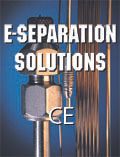Capillary Electrophoresis
Participants in this Tech Forum are Knut Wintergerst of Agilent Technologies, Hans Dewald of Beckman Coulter and Yolanda Fintschenko of LabSmith, Inc.

Capillary electrophoresis (CE) techniques have found use in many applications, including biological, pharmaceutical, chemical, and food analyses. Participants in this Tech Forum are Knut Wintergerst of Agilent Technologies, Hans Dewald of Beckman Coulter, and Yolanda Fintschenko of LabSmith, Inc.
What’s new in CE?
Wintergerst: In the past two years we have seen advances in the area of CE–mass spectrometry (MS) interfaces as well as MS sprayer sources, such as electrospray ionization (ESI), atmospheric pressure chemical ionization (APCI), and atmospheric pressure photoionization (APPI). The primary driver for this is to increase sensitivity and breadth of molecule classes (polar and nonpolar) that can be analyzed with CE–MS.
Dewald:Recently carbohydrate analysis by CE has been expanded to include separation of fucosylated, non-fucosylated, sialylated, bisecting, and high mannose isoforms of N-linked oligosaccharides in a single run. This means that factors important for therapeutic antibody efficacy can be better characterized.
Fintschenko:In addition to the increasing ease of use of instrumentation, the appearance of turnkey lab-on-a-chip CE–MS systems using microfluidics is an exciting development in CE.
Which applications have seen the greatest growth in recent years for CE?
Wintergerst:CE excels where liquid chromatography (LC) reaches its limits in terms of separation power and it is applied as orthogonal separation technique for target molecule validation. Given that, high growth applications revolve around validation, identification, and quality control of proteins and peptides for new biological entities (NBEs), as well as the detection of isomers. In particular isoelectric focusing (IEF) and capillary gel electrophoresis (CGE) are utilized to characterize proteins and peptides according to their charge and size.
Dewald:Applications related to the characterization of therapeutic proteins have led to the growth in capillary electrophoresis. These applications are protein purity by sodium dodecyl sulfate–molecular weight (SDS-MW) analysis, charge heterogeneity by capillary isoelectric focusing, and microheterogeneity determination through N-linked oligosaccharide labeling and analysis.
Fintschenko:The use of microfluidic systems that use CE for in vivo experimentation is an exciting application area that is growing. Additionally, one sees growth in CE lab-on-a-chip applications in areas as diverse as neuroscience, food and agriculture routine analysis, nanoparticle analysis and preparation, metabolomics/nutragenomics, and monitoring genetically engineered cell lines for biofuel creation. Additionally, the instruments available for DNA sequencing using CE has opened up the possibility of 1000 or more CE-array technology, which is very exciting for sample preparation and analysis for high throughput applications in biology and biomedical research.
Has CE instrumentation successfully made the transition from requiring expert training to being an option for routine use by less-experienced analysts?
Wintergerst:Traditional CE has only been adopted as routine technique in cases where methods have been fully developed and commercialized by CE instrument vendors. In these cases, complete reagent kits are available that don't require expert knowledge when used. Another route to developing CE into a routine analysis technique was taken by vendors of microfluidic devices. The powerful combination of electrophoresis with microfluidics channels, which act as capillaries, led to the successful development of devices that can be easily utilized by nonexpert users to quality control RNA, DNA, and protein samples.
Dewald:Over the last few years more and more biopharma companies are successfully transferring CE methods into quality control laboratories. Innovations in hardware, software and applications have facilitated this movement. A new instrument has been developed for routine use of CE, with user-friendly, easy to learn software which includes training videos that should allow more companies to take advantage of the benefits of CE.
Fintschenko:Working from the perspective of supporting scientists who use and develop new tools in R&D labs, current CE instrumentation looks suitable for the less-experienced analyst. Having said that, there seem to be growing applications where people want to exploit CE for new areas of research. As a result, one observes many home-built or modular systems in use for new applications or even morphed into hybrid tools. From the R&D perspective, this modular rather than turnkey approach is equally attractive and viable for some new CE applications as routine analysis.
Which application areas remain to be fully explored by CE users?
Wintergerst:Applications that require CE–MS techniques, such as metabolomics, remain to be fully explored by CE users. The great variety of metabolomic relevant molecules, as well as the demanding CE–MS (QTOF, QQQ) technique applied, make this a challenging endeavor for new entrants into this exciting application area.
Dewald:While CE–SDS has become the most popular CE technique for protein analysis the benefits of other applications like capillary IEF and glycan analysis for protein characterization are still being explored by a number of users.
Fintschenko:CE offers a unique solution for sample preparation and selective purification, particularly for preparative nanoparticle purification and also for bioanalysis. Generally, CE is applied as the analytical separation tool, but I think a real opportunity is being missed to give researchers a selective preparative tool. As the mass requirements of analysis are going down, there is great potential for relevant CE sample preparation, particularly in a high throughput, low limit-of-detection platforms afforded by MS and required by the increasing demands of in vivo analysis. Now that robust planar platforms and interconnects for CE exist, eliminating or reducing dead volume, routine CE methods for selective and high-throughput sample preparation or even preparative-scale applications deserve increased attention.
What lies in the future for CE?
Wintergerst:CE will very likely move from a single capillary, to a microfluidics approach. This is primarily driven by the capability of microfluidics devices to allow for faster time to result, superior quantification and sizing reproducibility, higher throughput, and ready to use reagent kits for nonexpert users.
Dewald:CE will become a mainstream analytical tool with advances in current technology making for easier, more robust and sensitive applications not only in biopharma but also in areas such as forensics, food and beverage, biofuels, agribusiness, and other industrial segments. CE–MS using sheathless coupling will prove to increase resolution and sensitivity and will profoundly change the future of CE. This technology will significantly increase the use of CE for protein, peptide, and metabolite analyses and will propel the technology into new areas altogether.
Fintschenko: The exploration of the investigation of electrophoresis and axial electric fields in nanofluidics opens up the possibilities of using what was simple CE with a single longitudinal electric field into a two-dimensional field flow fractionation tool — with the same applied electric field. The ability to apply both a longitudinal and axial electric field in a nanochannel using the same electric field creates exciting possibilities. For example, using a nanofluidic channel and an applied electric field, one can resolve biomolecules with the same mass-to-charge ratio, but different total number of charges. Nanofluidic electrophoresis has implications for developing new analysis tools for life sciences that are perhaps not true CE, but can take the benefit from previous work in CE and add additional power to traditional electrophoretic methods.
If you are interested in participating in any upcoming Technology Forums please contact Group Technical Editor Steve Brown or Associate Editor Meg Evans for more information. Next month’s forums will focus on the HPLC and Green Chemistry markets.
Assessing Safety of Medications During Pregnancy and Breastfeeding with LC–MS/MS
Published: April 8th 2025 | Updated: April 8th 2025Researchers conducted a study on medications used in psychiatry and neurology during the perinatal period, assessing how antiepileptic drugs (AEDs) affect placental functions, including transport mechanisms, nutrient transport, and trophoblast differentiation. Several quantitative methods, such as those for antianxiety and hypnotic drugs, were established to evaluate the safety of pharmacotherapy during breastfeeding using liquid chromatography-tandem mass spectrometry (LC–MS/MS).







